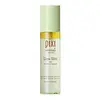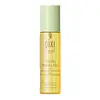What's inside
What's inside
 Key Ingredients
Key Ingredients

 Benefits
Benefits

 Concerns
Concerns

 Ingredients Side-by-side
Ingredients Side-by-side

Water
Skin ConditioningOlea Europaea Fruit Oil
MaskingDipropylene Glycol
HumectantButylene Glycol
HumectantPropolis Extract
Skin ConditioningNiacinamide
SmoothingArgania Spinosa Kernel Oil
EmollientAloe Barbadensis Leaf Extract
EmollientBetaine
HumectantSodium Hyaluronate
HumectantPEG/PPG-17/6 Copolymer
SolventPanthenol
Skin ConditioningCarthamus Tinctorius Seed Oil
MaskingPersea Gratissima Oil
Skin ConditioningOenothera Biennis Oil
EmollientRosa Canina Fruit Oil
EmollientSimmondsia Chinensis Seed Oil
EmollientMacadamia Integrifolia Seed Oil
Skin Conditioning1,2-Hexanediol
Skin ConditioningCaprylyl Glycol
EmollientIllicium Verum Fruit Extract
PerfumingAdenosine
Skin ConditioningRose Flower Oil
MaskingTagetes Minuta Flower Oil
MaskingMentha Arvensis Leaf Oil
MaskingElettaria Cardamomum Seed Oil
MaskingThymus Vulgaris Oil
MaskingEugenia Caryophyllus Leaf Oil
MaskingMelaleuca Alternifolia Leaf Oil
AntioxidantVetiveria Zizanoides Root Oil
MaskingCymbopogon Schoenanthus Oil
MaskingPelargonium Graveolens Flower Oil
MaskingLavandula Angustifolia Oil
MaskingCitrus Limon Peel Oil
MaskingCitrus Aurantium Dulcis Peel Oil
MaskingWater, Olea Europaea Fruit Oil, Dipropylene Glycol, Butylene Glycol, Propolis Extract, Niacinamide, Argania Spinosa Kernel Oil, Aloe Barbadensis Leaf Extract, Betaine, Sodium Hyaluronate, PEG/PPG-17/6 Copolymer, Panthenol, Carthamus Tinctorius Seed Oil, Persea Gratissima Oil, Oenothera Biennis Oil, Rosa Canina Fruit Oil, Simmondsia Chinensis Seed Oil, Macadamia Integrifolia Seed Oil, 1,2-Hexanediol, Caprylyl Glycol, Illicium Verum Fruit Extract, Adenosine, Rose Flower Oil, Tagetes Minuta Flower Oil, Mentha Arvensis Leaf Oil, Elettaria Cardamomum Seed Oil, Thymus Vulgaris Oil, Eugenia Caryophyllus Leaf Oil, Melaleuca Alternifolia Leaf Oil, Vetiveria Zizanoides Root Oil, Cymbopogon Schoenanthus Oil, Pelargonium Graveolens Flower Oil, Lavandula Angustifolia Oil, Citrus Limon Peel Oil, Citrus Aurantium Dulcis Peel Oil
Water
Skin ConditioningCitrus Aurantium Dulcis Flower Water
Skin ConditioningGlycerin
HumectantDipropylene Glycol
HumectantButylene Glycol
HumectantNiacinamide
SmoothingPEG-60 Hydrogenated Castor Oil
Emulsifying1,2-Hexanediol
Skin ConditioningCaprylyl Glycol
EmollientEthylhexylglycerin
Skin ConditioningAllantoin
Skin ConditioningMagnesium Ascorbyl Phosphate
AntioxidantCitric Acid
BufferingSodium Citrate
BufferingCitrus Grandis Peel Oil
MaskingAdenosine
Skin ConditioningTropolone
Skin ConditioningDisodium EDTA
Arginine
MaskingLavandula Angustifolia Oil
MaskingCitrus Sinensis Peel Oil Expressed
PerfumingSodium Hyaluronate
HumectantCitrus Aurantifolia Oil
CleansingGlycyrrhiza Glabra Root Extract
BleachingSodium Starch Octenylsuccinate
AbsorbentMaltodextrin
AbsorbentCalcium Pantothenate
Sodium Ascorbyl Phosphate
AntioxidantTocopheryl Acetate
AntioxidantPramoxine Hydrochloride
Silica
AbrasiveWater, Citrus Aurantium Dulcis Flower Water, Glycerin, Dipropylene Glycol, Butylene Glycol, Niacinamide, PEG-60 Hydrogenated Castor Oil, 1,2-Hexanediol, Caprylyl Glycol, Ethylhexylglycerin, Allantoin, Magnesium Ascorbyl Phosphate, Citric Acid, Sodium Citrate, Citrus Grandis Peel Oil, Adenosine, Tropolone, Disodium EDTA, Arginine, Lavandula Angustifolia Oil, Citrus Sinensis Peel Oil Expressed, Sodium Hyaluronate, Citrus Aurantifolia Oil, Glycyrrhiza Glabra Root Extract, Sodium Starch Octenylsuccinate, Maltodextrin, Calcium Pantothenate, Sodium Ascorbyl Phosphate, Tocopheryl Acetate, Pramoxine Hydrochloride, Silica
 Reviews
Reviews

Ingredients Explained
These ingredients are found in both products.
Ingredients higher up in an ingredient list are typically present in a larger amount.
1,2-Hexanediol is a synthetic liquid and another multi-functional powerhouse.
It is a:
- Humectant, drawing moisture into the skin
- Emollient, helping to soften skin
- Solvent, dispersing and stabilizing formulas
- Preservative booster, enhancing the antimicrobial activity of other preservatives
Adenosine is in every living organism. It is one of four components in nucleic acids that helps store our DNA.
Adenosine has many benefits when used. These benefits include hydrating the skin, smoothing skin, and reducing wrinkles. Once applied, adenosine increases collagen production. It also helps with improving firmness and tissue repair.
Studies have found adenosine may also help with wound healing.
In skincare products, Adenosine is usually derived from yeast.
Learn more about AdenosineButylene Glycol (or BG) is used within cosmetic products for a few different reasons:
Overall, Butylene Glycol is a safe and well-rounded ingredient that works well with other ingredients.
Though this ingredient works well with most skin types, some people with sensitive skin may experience a reaction such as allergic rashes, closed comedones, or itchiness.
Learn more about Butylene GlycolCaprylyl Glycol is a humectant and emollient, meaning it attracts and preserves moisture.
It is a common ingredient in many products, especially those designed to hydrate skin. The primary benefits are retaining moisture, skin softening, and promoting a healthy skin barrier.
Though Caprylyl Glycol is an alcohol derived from fatty acids, it is not the kind that can dry out skin.
This ingredient is also used as a preservative to extend the life of products. It has slight antimicrobial properties.
Learn more about Caprylyl GlycolDipropylene Glycol is a synthetically created humectant, stabilizer, and solvent.
This ingredient helps:
Dipropylene glycol is technically an alcohol, but it belongs to the glycol family (often considered part of the ‘good’ alcohols). This means it is hydrating and gentle on skin unlike drying solvent alcohols like denatured alcohol.
As a masking agent, Dipropylene Glycol can be used to cover the smell of other ingredients. However, it does not have a scent.
Studies show Dipropylene Glycol is considered safe to use in skincare.
Learn more about Dipropylene GlycolLavandula Angustifolia Oil is more commonly known as lavender essential oil. It is considered a fragrancing ingredient.
Lavender imparts a famous scent. While the smell is lovely, this ingredient and may sensitize skin in topical products. This is because about 85% of the oil is made up of linalool and linalyl acetate.
When exposed to air, these two compounds become strong allergens. This ingredient exhibits cytotoxicity at low concentrations; amounts of 0.25% have been shown to damage skin cells.
A study from Japan found this ingredient caused lavender sensitivity after widespread exposure.
Lavender essential oil has some antimicrobial, antibacterial, and anti-inflammatory properties. However, the cons of this ingredient may outweight the pros.
More research is needed to confirm lavender essential oil's effects when used in aromatherapy.
Lavandula Angustifolia is known as the English Lavender and famous for creating purple fields in Provence, France.
Learn more about Lavandula Angustifolia OilNiacinamide is a multitasking form of vitamin B3 that strengthens the skin barrier, reduces pores and dark spots, regulates oil, and improves signs of aging.
And the best part? It's gentle and well-tolerated by most skin types, including sensitive and reactive skin.
You might have heard of "niacin flush", or the reddening of skin that causes itchiness. Niacinamide has not been found to cause this.
In very rare cases, some individuals may not be able to tolerate niacinamide at all or experience an allergic reaction to it.
If you are experiencing flaking, irritation, and dryness with this ingredient, be sure to double check all your products as this ingredient can be found in all categories of skincare.
When incorporating niacinamide into your routine, look out for concentration amounts. Typically, 5% niacinamide provides benefits such as fading dark spots. However, if you have sensitive skin, it is better to begin with a smaller concentration.
When you apply niacinamide to your skin, your body converts it into nicotinamide adenine dinucleotide (NAD). NAD is an essential coenzyme that is already found in your cells as "fuel" and powers countless biological processes.
In your skin, NAD helps repair cell damage, produce new healthy cells, support collagen production, strengthen the skin barrier, and fight environmental stressors (like UV and pollution).
Our natural NAD levels start to decline with age, leading to slower skin repair, visible aging, and a weaker skin barrier. By providing your skin niacinamide, you're recharging your skin's NAD levels. This leads to stronger, healthier, and younger looking skin.
Another name for vitamin B3 is nicotinamide. This vitamin is water-soluble and our bodies don't store it. We obtain Vitamin B3 from either food or skincare. Meat, fish, wheat, yeast, and leafy greens contain vitamin B3.
The type of niacinamide used in skincare is synthetically created.
Learn more about NiacinamideSodium Hyaluronate is hyaluronic acid's salt form. It is commonly derived from the sodium salt of hyaluronic acid.
Like hyaluronic acid, it is great at holding water and acts as a humectant. This makes it a great skin hydrating ingredient.
Sodium Hyaluronate is naturally occurring in our bodies and is mostly found in eye fluid and joints.
These are some other common types of Hyaluronic Acid:
Learn more about Sodium HyaluronateWater. It's the most common cosmetic ingredient of all. You'll usually see it at the top of ingredient lists, meaning that it makes up the largest part of the product.
So why is it so popular? Water most often acts as a solvent - this means that it helps dissolve other ingredients into the formulation.
You'll also recognize water as that liquid we all need to stay alive. If you see this, drink a glass of water. Stay hydrated!
Learn more about Water